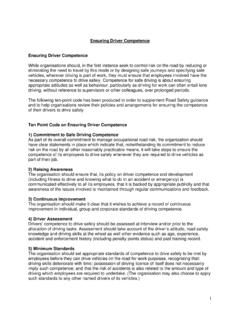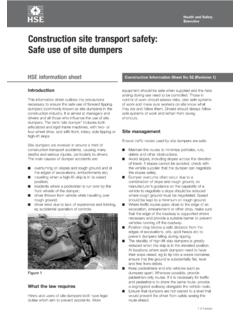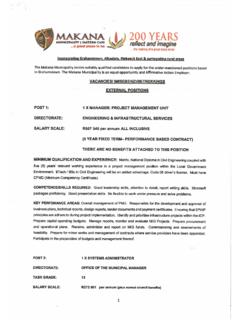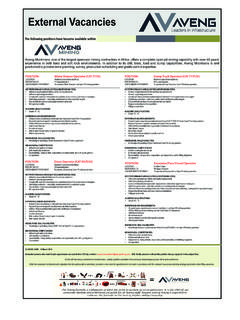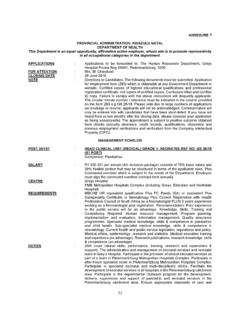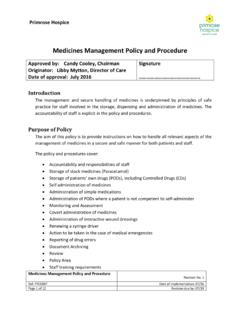Transcription of Using contractors: A brief guide INDG368(rev1)
1 Health and Safety ExecutiveUsing contractorsA brief guideUsing contractorsA brief guidePage 1 of 7 This is a web-friendly version of leaflet INDG368(rev1), published 06/12 This leaflet is aimed at businesses that use contractors. A contractor is anyone you ask to do work for you who is not an employee. The guidance tells you what you must do to comply with health and safety law when you use contractors. However, it doesn t apply to temporary or agency workers there is more specific information about them at The guide includes: Case studies that show the importance of taking the work of contractors seriously. Stop check! boxes that tell you when you may need to take extra steps and provide sources of more detailed guidance and industry-specific advice. A checklist at the end of the leaflet will help you ask the right questions and prioritise your responsibilitiesBoth you and the contractor you use have responsibilities under health and safety law.
2 Everyone needs to take the right precautions to reduce the risks of workplace dangers to employees and the public. Make sure everyone understands the part they need to play in ensuring health and you need to doIdentify the jobIdentify all aspects of the work you want the contractor to do. Consider the health and safety implications of the job. Remember, the level of risk will depend on the nature and complexity of the work. You should provide potential contractors with this information and make sure they know and understand the performance you expect of them. You could include this information in the job check! If the work is construction or building work, as the client you have duties under the Construction (Design and Management) Regulations 2007. You can find out more in the HSE leaflet Want construction work done safely?
3 A quick guide for clients on the Construction (Design and Management) Regulations 2007. If you are a small to medium-sized chemical company, there is more detailed guidance in Managing contractors: A guide for employers. Health and Safety ExecutiveUsing contractors: A brief guide Page 2 of 7 Select a suitable contractorYou will need to satisfy yourself that the contractor you choose can do the job safely and without risks to health. This means making enquiries about the competence of the contractor do they have the right combination of skills, experience and knowledge? The degree of competence required will depend on the work. Similarly, the level of enquiries you make should be determined by the level of risks and the complexity of the job. Examples of questions you could ask potential contractors include:What arrangements will you have for managing the work?
4 For example, who will be responsible, how will the work be supervised, what checks do you make on equipment and materials etc?Will you be Using subcontractors and if so how will you check they are competent? The level of competence for subcontractors will depend on the risk and the complexity of the is your recent health and safety performance? For example, how many accidents and cases of ill health have you had, has HSE taken any action taken against you?Do you have a written health and safety policy? (This is only a requirement if five or more people are employed.)Can you provide existing risk assessments done for similar jobs? Again, written risk assessments are only required by law if five or more people are qualifications, skills and experience do you have in this type of work? What health and safety information and training do you provide for your workers?
5 If required, do you have Employers Liability Compulsory Insurance? These questions will help you find out whether the contractor is complying with their duties under health and safety law. You can then decide how much evidence is needed to support what you have been questions you can ask which may help you to decide which contractor to choose include:Do they have any independent assessment of their competence? Are they members of a trade association or professional body? Will they be producing a safety method statement for the job? A safety method statement is not required by law. It does however describe in a logical sequence exactly how a job is to be carried out in a safe manner and without risks to health. It includes all the risks identified in the risk assessment and the measures needed to control those risks.
6 This allows the job to be properly planned and resourced. Case studyA tree surgeon was felling a branch, when it fell into a neighbouring garden, damaging a fence panel. An hour earlier the neighbour had been in the garden playing with her 20-month-old child. The tree surgeon had neither the qualifications to use a chainsaw nor the skill to carry out the job safely. If the property developer who hired the tree surgeon had checked that he was competent to carry out the work, this incident would have been avoided. Don t assume someone is competent, check it and Safety ExecutiveUsing contractors: A brief guide Page 3 of 7 Assess the risks of the workBoth you and the contractor need to think about the planned work: What can harm people? Who might be harmed and how? How will you control the risks?
7 You can find more detailed information on risk assessment and control at should already have a risk assessment for the work activities of your own business. Make sure your assessment covers risks to contractors from your business (eg asbestos, on-site vehicles). The contractor must assess the risks for the contracted work and then both of you must get together to consider any risks from each other s work that could affect the health and safety of the workforce or anyone need to think about any risks to your workers and members of the public, because you have contractors on site. Also, make sure you agree the measures needed to control risk with the contractor before work check! Include health risks, such as high levels of noise or exposure to harmful substances, as well as safety risks.
8 Once you have agreed action to control risks, be clear about who will do what and when. An easy way to communicate and record your findings is to use the risk assessment template ( ). There are specific requirements for some higher risk workplaces. For more information go to HSE s industries pages at Case studyA worker was killed when she was run over by a vehicle operated by a contractor. Neither the employer nor the contractor had identified pedestrian routes to keep pedestrians separate from moving vehicles. Additionally, the contractor hadn t given his drivers adequate training to make sure they operated the vehicles safely. The employer should have identified risks from the contractor being on site and agreed measures to control those risks before the work started. Provide information, instruction and trainingYou and the contractor need to communicate with each other throughout the process.
9 Make sure that the contractor and their employees have information on:health and safety risks they may face; measures in place to deal with those risks; your emergency procedures. The information you provide should be in a form that is easy to , you must provide clear instructions, information and adequate training for your own and Safety ExecutiveUsing contractors: A brief guide Page 4 of 7 Stop check! For more advice, see HSE s leaflet Health and safety training: What you need to know. Pay particular attention to those whose first language may not be English see HSE s migrant workers web pages for more information, at studyA farm worker received internal injuries and severe burns from electric shock when he lifted an irrigation pipe and it contacted 33 000 V overhead power lines.
10 The employer had not discussed the presence of the overhead lines and identified a safe way of moving the irrigation pipes. The employer should have made the contractor aware of the risks he faced and agreed a method of work before the job was started. Don t assume that contractors will be aware of all risks, even if they seem obvious to you. Cooperate and coordinate with the contractor You and the contractor must work together and coordinate your activities, to make sure the work can be done safely and without risks to health. One way of doing this is to have regular meetings throughout. The level of cooperation and coordination needed will depend on:the job to be done; the number of contractors (or subcontractors) involved; the risks involved. Case studyA delivery driver was injured when a lift truck hit him as he walked into a factory to find out where he should deliver his load.










